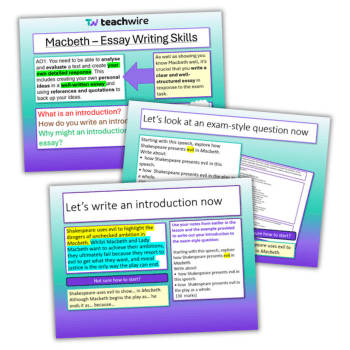How to Get GCSE Students to Plan and Write English Literature Essays that Fully Demonstrate their Understanding

“Why on earth have they included that quote, when this one would clearly have been a much better choice?” Sound familiar? Here's how students can avoid this and other issues, says Fiona Ritson…

- by Fiona Ritson

A full set of resources to accompany this feature can be downloaded for free here.
Calling all English teachers: does this sound familiar? You’ve read a GCSE text with your class, and used resources you’ve painstakingly made in order to get them thinking more deeply.
As you go through extracts in the last lesson on Friday afternoon, you ask carefully crafted questions, and note with satisfaction how students shoot their hands up in a flash, like Barry Allen on the run.
You collect a pile of books containing essays, and plonk them in the boot of your car, smiling at the moments of brilliance you expect to see in your students’ work. Later, back at home, you mark them. And that’s when your world comes to an abrupt stop.
What went wrong? Because what you are seeing doesn’t remotely resemble what you taught – were you even in the room? Why on earth have they included that quote, when this one would clearly have been a much better choice, leading to some fantastic analysis?
Could it be… because you didn’t actually prepare them properly for what they needed to do?
All the way
Despite timetable constraints and pressure for schools, I strongly advise reading any GCSE text cover to cover with students.
This may sound obvious – but, blasphemous though many will find it, I’ve heard rumours of schools simply handing out extracts with summaries to bridge the gaps in missing knowledge and content.
However, the only way students will be able to write articulate essays is if they know the text inside out.
Moreover, whether we like it or not, pupils need to understand the exam specification. This doesn’t mean teaching to the test, but they do need to know what to do so that they can move up the levels on a mark scheme, and this means recognising the language of that mark scheme.
Each exam board uses the same Assessment Objectives, but they’re weighted differently across the two papers for each board. Some need context, some are a comparison, and so on. You and your students should know them inside out.
Plan, plan and plan!
For the English literature GCSE exam, students have to write an articulate essay to an unseen question, sustained over the whole piece, in about 30-60 mins (depending on question/exam board), showing clear understanding of the text and context, all whilst under pressure.
As teachers, we have to prepare them as much as possible. Five minutes planning an essay could ensure students don’t go off track because they’ve lost the question focus.
And teaching how to write effective introductions helps pupils not only to focus the start of the essay, but also to shape the direction and their ideas for the rest of their response.
Students need to consider the question, character or theme, at all times. A literature exam will always consider what the text is about, for example the actual content and themes or ideas the author is exploring.
The other consideration is how the text is written – so, the techniques used by the author through language, structural features, setting, characters etc. These are the key elements pupils should be covering in their responses:
- Character
Students need to consider a character from many viewpoints; are they liked/disliked, and why are they important to the novel/plot? Is there a theme explored through a particular character? How do we feel as a reader towards them? How are they treated by other characters? And finally, do they change – do they learn anything across the story?
Learners must understand the themes explored in a text and how they are linked to the characters and storyline, as well as contextual information at the time of writing.
This should be the easiest, the words on the page, but often students move swiftly past words or phrases, focusing on quotes that lead to poor analysis. Students need to look for key words/phrases that answer the question. I’ve used a simple system for years. When I read the extract I begin to underline words or phrases that jump out at me. Once I see a pattern, repetition, synonym or even antonym of a previously underlined word I circle it. This means when I get to the end I can quickly see key words/phrases and patterns across the text. However, regardless of any little tricks they might use, students need to actually analyse the quote/words they’ve picked for meaning!
Sometimes we get students to analyse language but for them the technique is an afterthought. Why did an author pick a metaphor or oxymoron at that point, how is that technique effective and, for example, how does the comparison add to overall meaning?
Analysing structure seems to present students with an especial challenge. They need to consider paragraphs, sentence types, punctuation, word order, clause order and how the extract begins and ends. How does the genre of the text add to meaning or contribute to author’s intent? Does the extract follow a particular character’s thoughts or feelings and if so why; and more importantly, do they change over the extract?
Here, students need to look for shifts in tone, subtle choices made by the author that carry as much impact as the words. Who is speaking and why? How does this add to overall meaning?
Where is the extract or that section set, why is that important? How does it add to the atmosphere? Does it change the way characters think or feel? I always advise students to pick around eight to ten quotes from across the extract or whole text covering language, techniques and structure – and remind them constantly that it’s not enough just to include a quote; they need to explain why it’s significant, too!
Finally, of course, students need to finish their essay with a conclusion that summarises the author’s intent covering the question and their initial introduction.
3 Sources of support
For further help and guidance, try the following:
- Read Bringing Words to Life (Isabel L Beck, Margaret G McKeown, Linda Kucan) and Closing the Vocab Gap (Alex Quigley) if you haven’t already. Students need to understand tier two language; how to write about it and how to analyse it. They need to signpost their essay making strong connections in the extract or whole text.
- Get yourself on Twitter and find the English community using the #teamenglish hashtag, where teachers up and down the country share resources and their time freely.
- Sign up to Litdrive, a free site for English teachers to share resources.
Fiona Ritson is an English teacher in the South East of England. Find her on twitter, @AlwaysLearnWeb, where she regularly shares KS3 and 4 resources with #TeamEnglish. Download our free Macbeth essay two-lesson resource pack and browse great ideas to help with GCSE English Language revision.











